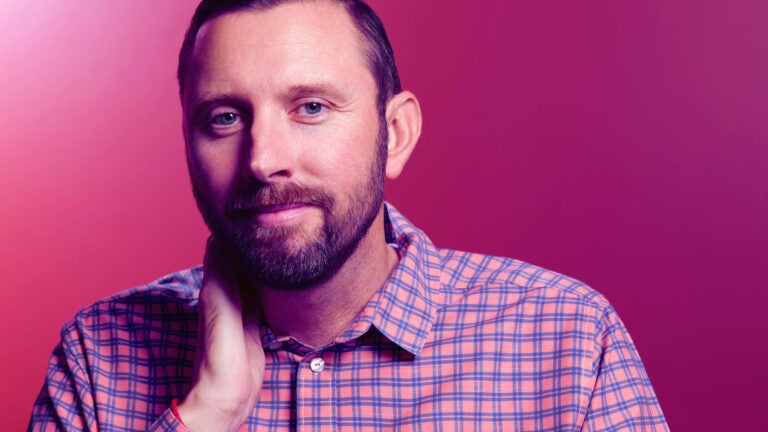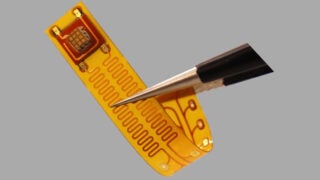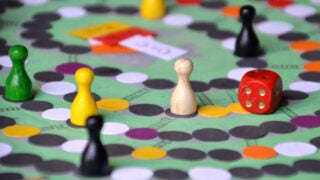
USC doctors, staff help a single dad deal with Lou Gehrig’s disease
ALS Clinic treats the needs of Shaun Kalpakoff, fighting the disease while striving to maintain the bond with his young son
https://www.youtube.com/watch?v=tq7hVHSGMtY&feature=youtu.be
It seems like every week Shaun Kalpakoff discovers there’s something new he can no longer do without assistance.
The 37-year-old single father is one of an estimated 20,000 Americans who live with amyotrophic lateral sclerosis (ALS), a progressive neurodegenerative disease that kills motor neurons. Also known as Lou Gehrig’s disease, ALS causes a person’s muscles to weaken and atrophy, ultimately leading to paralysis. As the disease advances, a person loses the ability to walk, speak, swallow and eventually breathe.
Stunning diagnosis for a father with ALS
For Kalpakoff, it all started two years ago when he broke his right heel bone in a running-related accident.
“I crushed that thing like an egg into 15 pieces,” said Kalpakoff, who lives in Yorba Linda.
After a three-month recovery period, Kalpakoff noticed something strange: His left foot, which hadn’t been injured, had grown significantly weaker and was experiencing foot drop — difficulty lifting the front part of the foot due to weakness.
When eight months of testing with several doctors led to inconclusive results, he was referred to the Keck Hospital of USC. In September 2017, he was diagnosed with ALS.
The diagnosis was shocking for Kalpakoff, who had always led an active lifestyle.
“It kind of floored me for at least a month or two where I didn’t talk,” said Kalpakoff, who has lost 35 pounds in the last 18 months — a side effect of ALS. “I didn’t share this information with anyone besides my family and my close friends at first.”
Life expectancy varies from person to person, but according to the ALS Association, half of people diagnosed with ALS live at least three years or more after being diagnosed; 20 percent live up to five years or more.
However, research has shown that participating in a multidisciplinary ALS clinic can prolong survival and improve quality of life.
USC ALS Clinic: Treatment focusing on each individual
USC’s ALS Clinic uses an interdisciplinary and collaborative model to address an individual’s needs following an ALS diagnosis through a cohesive and individualized plan.
Equipped with state-of-the-art equipment, the clinic can run diagnostic tests such as electromyograms and nerve conduction studies to provide an accurate diagnosis and guide treatment.
The clinic houses a wide variety of disciplines, including occupational therapy, physical therapy, social work, neurology, nutrition, speech therapy, pulmonology as well as a community partner from the ALS Association.
Kalpakoff had heard about the clinic shortly after his diagnosis. He said it is convenient because instead of having to schedule separate appointments with doctors, he can get a comprehensive checkup every three months.
“It’s like a round-robin thing,” Kalpakoff said. “You get a 30-minute visit with all these doctors. It’s exhausting for the patients, but it’s good to get it all out of the way.”
Maintaining his independence
One of the doctors he regularly sees is Nora Darakjian, an instructor of clinical physical therapy.
Physical therapy improves the quality of life for individuals with ALS. It allows them to stay independent for as long as possible.
Nora Darakjian
“Physical therapy improves the quality of life for individuals with ALS,” Darakjian said. “It allows them to stay independent for as long as possible.”
Darakjian said the clinic is especially equipped to handle ALS cases because it has therapists with board certification in neurological physical therapy.
“This allows therapists to provide more specialized, evidence-based care to individuals with ALS,” she said.
Kalpakoff credits Darakjian with helping him stay mobile as long as possible by recommending equipment such as ankle foot orthoses and canes and teaching him energy-conservation techniques and postural management tips.
“I don’t like listening to many people,” Kalpakoff said. “But I trust her, so we have a good relationship.”
Darakjian considers Kalpakoff an inspiration.
“He has a positive outlook and very clear goals for his care,” she said. “He is very aware of his functional needs, and we partner in problem-solving his mobility needs.”
Although Kalpakoff must now use a wheelchair, Darakjian keeps him moving.
“We’re doing mostly range of motion and different kinds of stretching that I need to do at home to keep myself kind of limber,” said Kalpakoff, who manages a family-owned waste management company. “She gives me a lot of ideas and things to do at home when I’m not with her. I have a lot of back and neck problems now just because my body is weak.”
Darakjian is currently focusing on optimizing Kalpakoff’s respiratory function and posture to help manage his neck and back pain.
“We want him sitting and standing up tall in all his photographs with friends and family,” she said.
USC ALS Clinic: Doing whatever it takes
For Kalpakoff, spending quality time with the people he cares about has become his top priority, especially his 10-year-old son, Ashton.
Like his father, Ashton also enjoys sports and currently holds a blue belt in karate. While he is aware that his father is ill, he doesn’t know all the details.
“I just tell him, ‘Daddy’s muscles are weak and are getting weaker,’” Kalpakoff explained. “That’s the only thing I tell him. It’s a hard topic to tell your son.”
Despite his physical limitations, Kalpakoff and his son still find ways to have fun, like riding an electric-powered three-wheel bike together.
“Anything that sounds fun, we go do it,” Kalpakoff said. “Everywhere that we go, we kind of have an adventure.”
Being diagnosed with ALS has changed Kalpakoff’s life outlook, which has been liberating, he said.
I’ve become more open, not really scared to express my feelings. There’s a lot more to life than everything that you’re trained to believe is important.
Shaun Kalpakoff
“You start thinking more about creating memories and creating a lasting impact,” he said. “It’s made me a lot better of a person, I think. I’ve become more open, not really scared to express my feelings. There’s a lot more to life than everything that you’re trained to believe is important.”
On Sept. 7, 2018 — exactly a year after his diagnosis — Kalpakoff made his condition public on Facebook. Among his reasons for doing so, he wrote, was Ashton.
“When I watch my son Ashton make good choices and be kind to others, I get this feeling that cannot be explained,” he wrote. “He is my driving factor that keeps me focused, positive and willing to do whatever it takes. I sincerely hope each and every person who reads this message has someone — not something — that fulfills that feeling. If you don’t, I challenge you to go out and find that person.”



